Introduction to Egyptian Mythology

Ancient Egyptian Pantheon is a rich and complex belief system that emerged thousands of years ago in ancient Egypt. It played a central role in the lives of the ancient Egyptians, influencing their religious practices, art, and society as a whole. Understanding the gods and their symbolism is essential to comprehending the intricate tapestry of this ancient pantheon.
Egyptian mythology is unique in many aspects. Unlike other mythologies that often center around a single supreme deity, the Egyptian pantheon consisted of a vast array of gods and goddesses, each with their own distinct characteristics and roles. These deities represented various aspects of the natural world, society, and human emotions. As such, they were not just mere divine beings but also symbols of the forces and powers that governed different aspects of life.
The deities of Ancient Egyptian Pantheon were often depicted as part-human, part-animal figures, conveying a sense of their multifaceted nature and the connection between the human and animal realms. For example, the god Horus was represented as a falcon-headed deity, symbolizing his association with the sky and his role as a guardian and protector. These animalistic depictions were not meant to be taken literally, but rather as symbolic representations of the divine qualities and characteristics of the gods.
In addition to their physical representations, the gods and goddesses of Ancient Egyptian Pantheon were also associated with specific symbols and objects. These symbols were used to identify and invoke the presence and powers of a particular deity. For instance, the ankh, a looped cross, was a symbol of life and fertility, often associated with the goddess Isis. The sun disk, known as the Aten, was a symbol of the sun god Ra, representing light and warmth. These symbols played a significant role in religious rituals and artistic depictions, serving as a visual language for the gods and their attributes.
Egyptian mythology encompasses a vast array of stories and legends, offering insights into the cosmology, creation myths, and the interactions between gods and mortals. These myths explain the origins and order of the universe, the cycle of life and death, and the complexities of human existence. They provided meaning and purpose to the ancient Egyptians, shaping their understanding of the world and their place within it.
To truly grasp the significance of Ancient Egyptian Pantheon, one must delve into the stories and symbolism that define this ancient belief system. From the creation myth of the god Atum to the epic battles between Horus and Set, each tale offers a glimpse into the profound and mystifying world of the Egyptian gods. By exploring their myths and understanding their symbolism, we can unlock the secrets of an ancient civilization and gain a deeper appreciation for the enduring legacy of Egyptian mythology.
"Egyptian mythology is a fascinating and intricate belief system that shaped the lives and culture of the ancient Egyptians. From the vast pantheon of gods and goddesses to the symbolism and mythological tales, it provides a captivating glimpse into the ancient world. Exploring Egyptian mythology is like embarking on a mystical journey through time, unraveling the mysteries of a bygone civilization."
Creation Myths and the Egyptian Pantheon
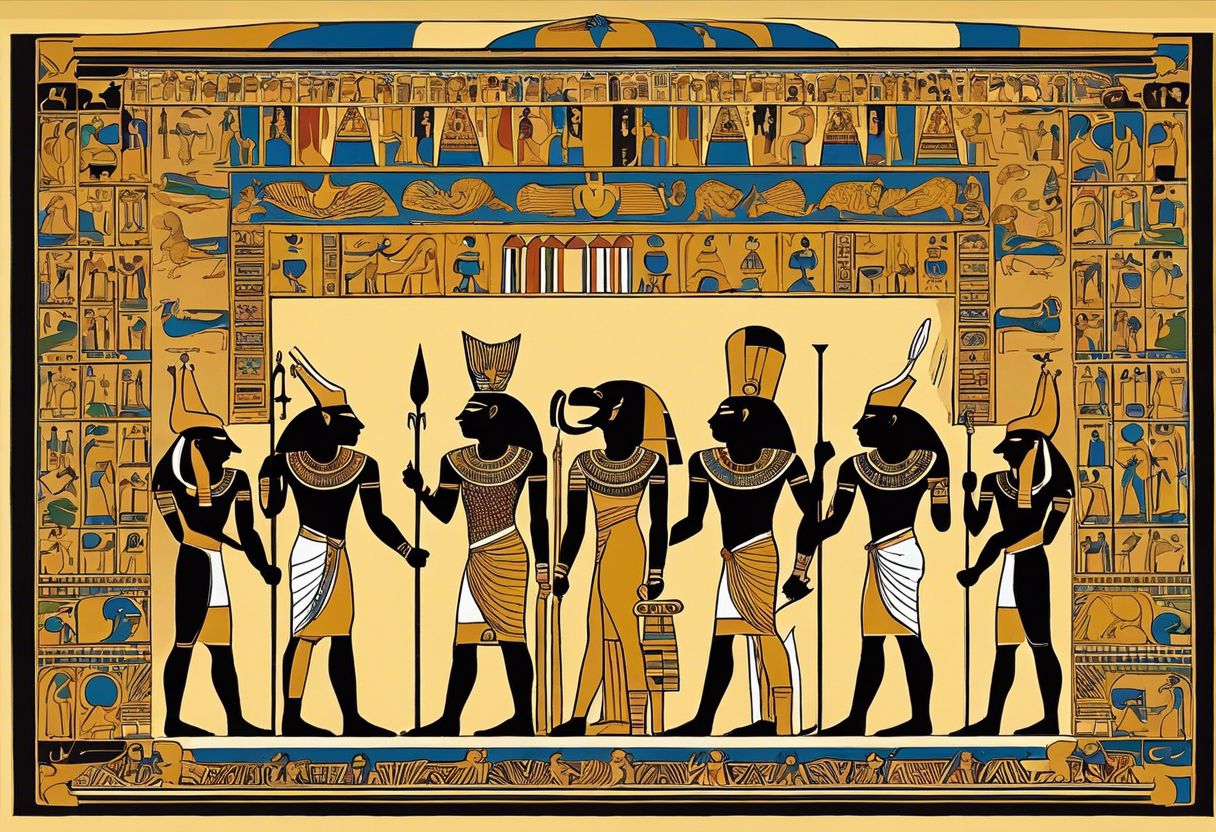
In understanding the gods and their symbolism in the ancient Egyptian pantheon, it is crucial to explore the creation myths that shaped their existence and roles in the Egyptian culture. These creation myths provide insights into the beliefs and values of the ancient Egyptians, as well as shed light on the origins of the gods themselves.
One prominent creation myth in Egyptian mythology is the Heliopolitan cosmogony. According to this myth, the world emerged from the primordial waters of Nun, personified as a chaotic, limitless ocean. From Nun, a mound rose, and on top of it stood the god Atum. Atum then proceeded to bring forth other gods, forming the first divine generation. This creation story symbolizes the Egyptians' belief in the cyclical nature of the universe, with an eternal cycle of creation and rejuvenation.
Another significant creation myth is the Memphite cosmogony, which centers around the god Ptah. In this myth, Ptah is considered the creator of the universe through the power of his heart and tongue. He spoke words of creation, and the world came into being. Ptah's association with the creative power of speech reflects the Egyptians' belief in the power of language and thought in shaping reality.
These creation myths set the stage for the Egyptian pantheon, which comprises a complex interplay of gods and goddesses with various roles and attributes. The pantheon is vast and diverse, with each deity embodying a particular aspect of nature, society, or cosmic order. For instance, Osiris, the god of the dead, represents the cycle of life, death, and rebirth, while Thoth, the god of wisdom, is associated with knowledge and writing.
The Egyptian pantheon also includes many deities who are anthropomorphic, that is, depicted with human bodies and animal heads. This combination of human and animal characteristics reflects the Egyptians' belief in the interconnectedness of the natural and divine realms. By embodying both human and animal qualities, these gods bridge the gap between the human and divine worlds.
The gods and goddesses of the Egyptian pantheon were not only worshipped but also venerated through rituals and offerings. Temples dedicated to different gods were built throughout Egypt, and priests served as intermediaries between the gods and humans. Offerings of food, drink, and other precious items were made to appease the gods and seek their blessings.
In summary, ancient Egyptian creation myths provide a foundation for understanding the gods and their symbolism in the Egyptian pantheon. These myths convey the Egyptians' beliefs in the cyclical nature of the universe, the power of speech and thought, and the interconnectedness of the natural and divine realms. The pantheon itself consists of numerous deities, each representing different aspects of life and embodying both human and animal qualities. The gods and goddesses were revered through rituals and offerings, emphasizing the importance of maintaining a harmonious relationship with the divine realm.
The Major Gods and Goddesses of Ancient Egypt
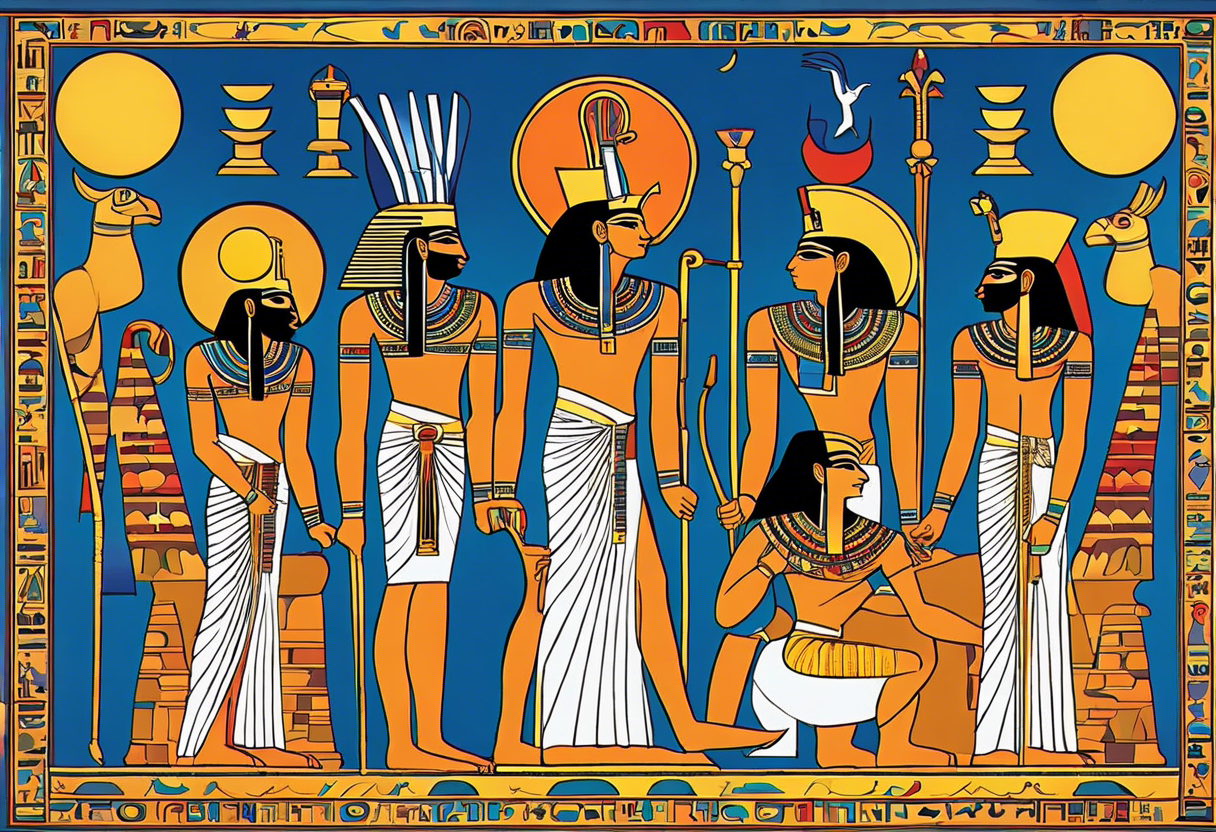
The ancient Egyptian pantheon consisted of a vast array of gods and goddesses, each representing different aspects of life and nature. These deities played a significant role in the religious and spiritual beliefs of the ancient Egyptians. Here are some of the major gods and goddesses of ancient Egypt:
Ra: Ra was the sun god and one of the most important deities in Egyptian mythology. As the creator and ruler of the world, he symbolized power and light. Ra was often depicted with the head of a falcon and a sun disk on top. The sun was considered to be his body, and it was believed that he journeyed through the sky during the day and sailed through the underworld at night.
Isis: Isis was the goddess of magic, fertility, and motherhood. She was also associated with healing and protection. Isis was highly revered and known for her role as a devoted wife to her husband Osiris and as the mother of Horus, the falcon-headed sky god. She was often depicted as a woman wearing a headdress shaped like a throne or as a mother nursing her son.
Osiris: Osiris was the god of the afterlife, resurrection, and fertility. He played a crucial role in ancient Egyptian mythology as the judge of the dead and the ruler of the underworld. Osiris was usually depicted as a mummified figure wrapped in linen, symbolizing the cycle of life, death, and rebirth.
Horus: Horus was the god of the sky, kingship, and protection. He was considered the son of Isis and Osiris and was often depicted as a falcon-headed deity or as a falcon with the sun disk on his head. Horus was known for his role in avenging his father's death and restoring order to Egypt.
Anubis: Anubis was the god of embalming and the protector of the dead. He was depicted as a jackal-headed figure or as a jackal lying on a funerary bier. Anubis played a crucial role in the mummification process and guiding souls into the afterlife.
Thoth: Thoth was the god of wisdom, writing, and magic. He was often depicted as an ibis or as a human with the head of an ibis. Thoth was associated with the invention of writing and the keeper of knowledge. He was regarded as the scribe of the gods and the mediator between the living and the dead.
Throughout ancient Egyptian history, various gods and goddesses gained prominence or fused with others as their roles and characteristics evolved. These deities represented the diverse aspects of life, mortality, and the natural world. The ancient Egyptians worshiped and revered these gods, believing that they held great power and influence over their daily lives.
The Role of Gods in Daily Life
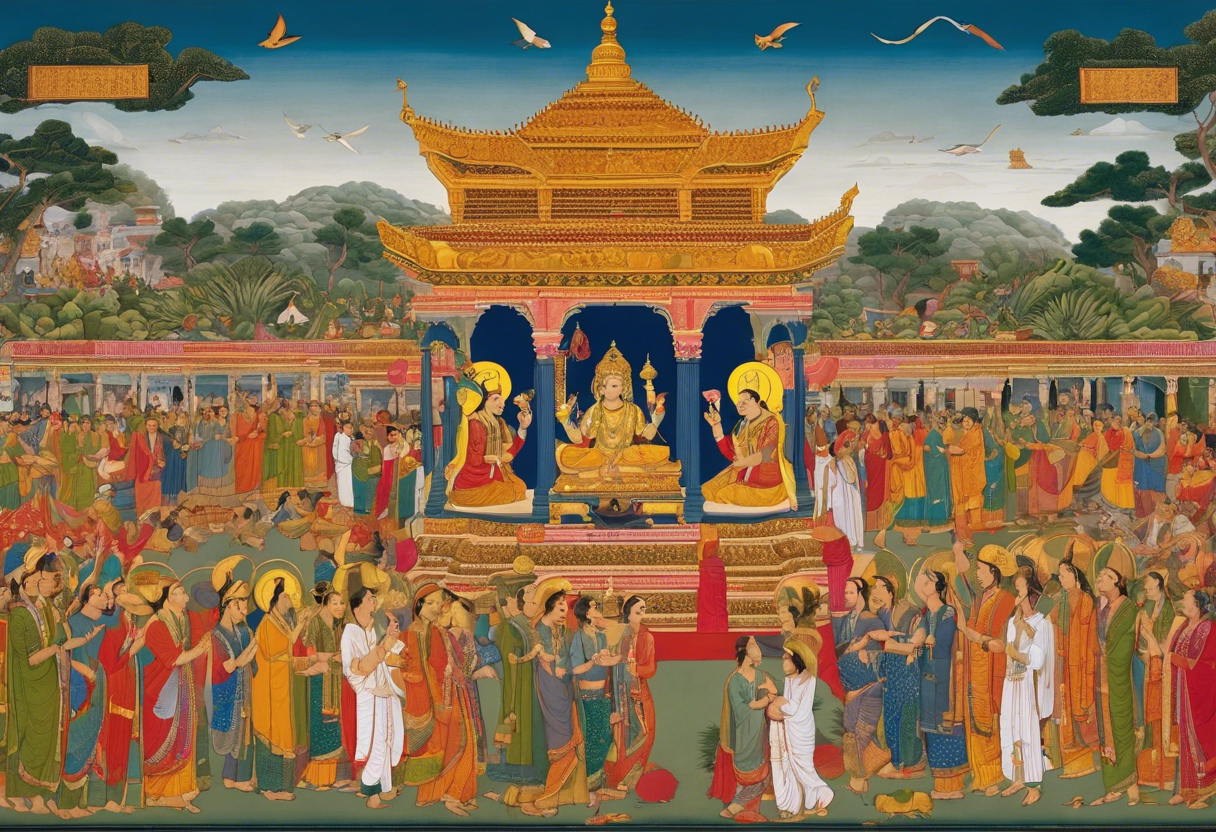
In ancient Egypt, the gods played a central role in daily life and were deeply integrated into every aspect of society. The Egyptians believed that the gods were not distant and detached figures, but rather active participants in their daily affairs. They viewed the gods as powerful beings who controlled various aspects of nature and human existence.
One of the primary roles of the gods in daily life was to maintain order and balance in the world. The Egyptians believed that the gods governed every aspect of the natural world, from the rising and setting of the sun to the flooding of the Nile River, which was essential for their agriculture-based economy. They believed that by appeasing the gods through rituals and offerings, they could ensure the continued stability of these natural phenomena.
The gods were also seen as protectors and patrons of specific activities or occupations. For example, the god Ptah was associated with craftsmen and artists, while the goddess Isis was revered as the protectress of mothers and children. The Egyptians sought the gods' favor and assistance by making offerings and prayers specific to their respective domains.
The gods were not only important in religious practices, but they also played a role in the governance of the society. The pharaoh, the ruler of ancient Egypt, was believed to be the earthly embodiment of the god Horus, and therefore, his authority was considered divine. The pharaoh would consult with the gods through oracles and make important decisions based on their guidance.
In addition to their role in daily life, the gods also offered hope and solace in times of hardship. The Egyptians believed that the gods could intervene in human affairs and provide protection, healing, and prosperity. Individuals would often turn to the gods in times of illness or personal crisis, seeking their divine intervention and assistance.
To honor and communicate with the gods, the Egyptians built magnificent temples and conducted elaborate rituals. These rituals involved offerings of food, drink, and incense, as well as prayers and hymns. The priests, who served as intermediaries between the gods and the people, performed these rituals on behalf of the community.
In summary, the gods held a central and active role in the daily lives of the ancient Egyptians. From maintaining order in the natural world to guiding human affairs, the gods were deeply integrated into every aspect of society. They were both revered figures and sources of comfort, providing protection, guidance, and hope to the individuals and the community as a whole. The rituals, offerings, and temples dedicated to the gods were a testament to their significance and influence in ancient Egyptian society.
Mythological Stories and Legends
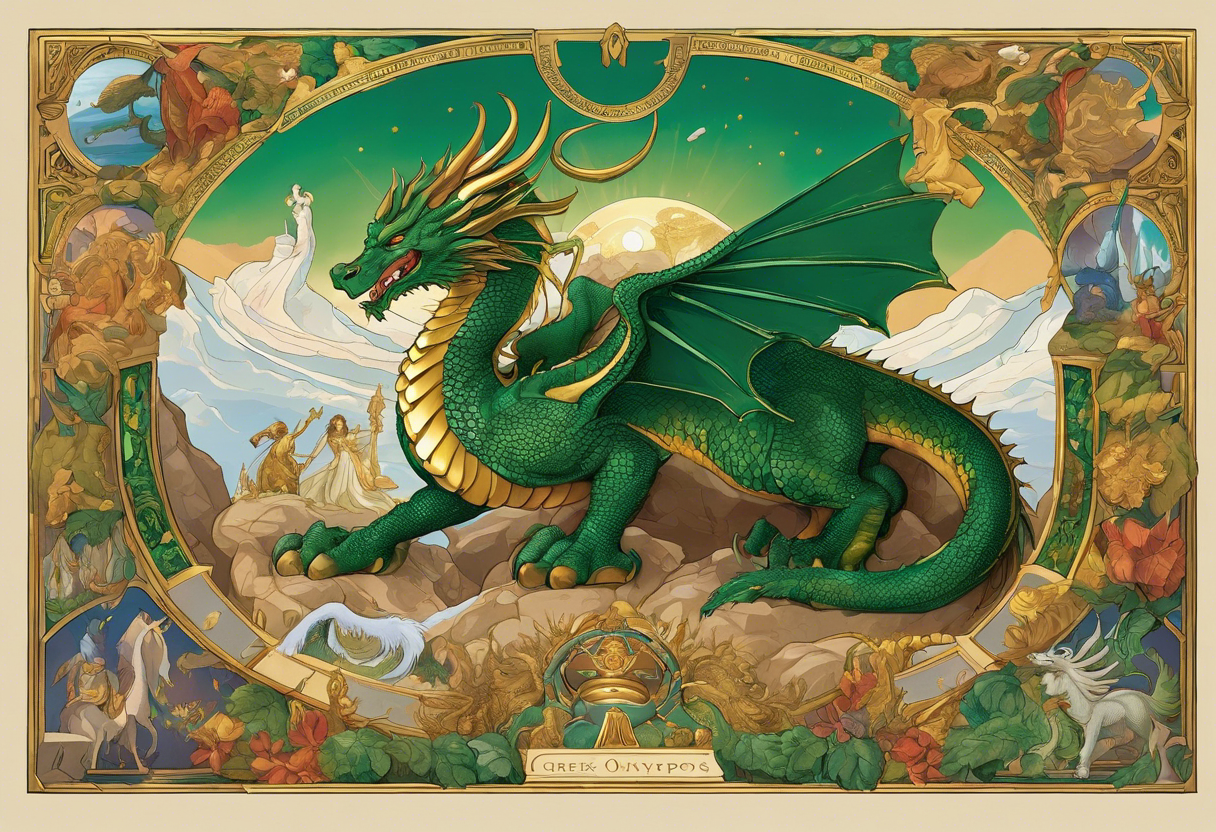
The ancient Egyptian civilization is steeped in a rich tapestry of mythological stories and legends that provide insights into their beliefs, values, and culture. These stories feature a wide array of gods and goddesses with extraordinary powers and abilities. Here are some of the most fascinating myths and legends from the ancient Egyptian pantheon:
The Creation Myth: In the creation myth, it is believed that before the existence of the world, there was only a vast, chaotic ocean known as "Nu." From this ocean emerged a primordial mound called "Benben," representing the first land. The god Atum, the supreme creator, rose from the Benben and brought forth life by creating other gods and goddesses. This myth symbolizes the Egyptians' belief in the cyclical nature of life and the importance of order in the world.
The Gods of the Ennead: The Ennead is a group of nine gods led by Atum. Each member of the Ennead played a significant role in the cosmos and held sway over various aspects of life. For example, Osiris, the god of the afterlife, was responsible for the judgment of souls, while Hathor, the goddess of love and fertility, ensured the continuation of life. These gods and goddesses were deeply revered and worshipped throughout ancient Egypt.
The Myth of Osiris: One of the most well-known ancient Egyptian myths is that of Osiris, the god of the afterlife and fertility. According to the myth, Osiris was murdered by his brother Seth out of jealousy. Osiris' body was dismembered and scattered across Egypt, but his sister and wife, Isis, managed to find and reassemble his body. With the help of the god Thoth, Osiris was brought back to life briefly, allowing him to father Horus, the falcon-headed god. This myth emphasizes the cycles of life, death, and rebirth.
The Legend of Ra and the Sun: Ra, the sun god, was believed to be the supreme ruler of the gods. According to the legend, Ra traveled across the sky during the day in his solar boat, lighting up the world. At night, he would journey through the underworld, battling against the forces of chaos. This myth symbolized the eternal struggle between order and chaos and highlighted the critical role of the sun in providing sustenance and life to the Egyptians.
The Myth of the Nile: The Nile River held immense importance in ancient Egypt, as it was the source of life and fertility for the civilization. According to the myth, the flooding of the Nile was believed to be caused by the god Hapi. Hapi was depicted as a plump figure, symbolizing abundance, and was worshipped for the prosperity and sustenance the Nile provided. This myth illustrates the Egyptians' deep connection to the natural world and their reliance on its bounties.
These mythological stories and legends are just a glimpse into the profound beliefs and symbolism of the ancient Egyptian civilization. They offer a captivating insight into their worldview and their devotion to the gods and goddesses who governed various aspects of their lives. Moreover, these myths and legends continue to captivate and inspire people to this day, showcasing the enduring legacy of the ancient Egyptian pantheon.
The Afterlife and Egyptian Gods
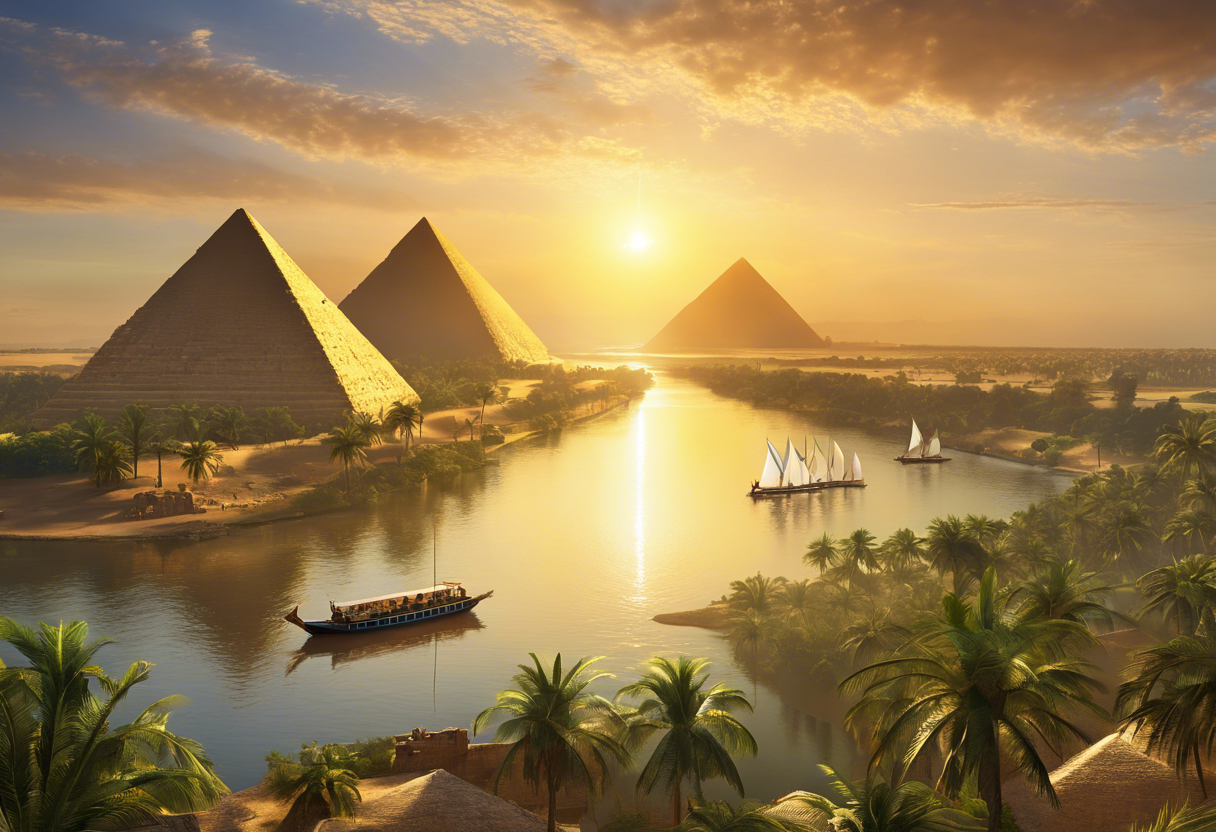
The concept of the afterlife held great significance in ancient Egyptian culture. The Egyptians believed that life did not simply end with death, but rather, it transitioned into a new phase in the afterlife. To navigate this afterlife, the guidance and protection of the gods were indispensable.
The Judgment of the Dead
In the Egyptian belief system, it was believed that after death, the soul would embark on a journey to the Hall of Ma'at, where the heart of the deceased would be weighed against the feather of Ma'at, the goddess of truth and justice. This judgment determined the fate of the individual in the afterlife. If the heart was found to be pure and free from the weight of sin, the soul would be granted eternal life. However, if the heart was heavy with wrongdoing, it would be devoured by the demon Ammit, resulting in eternal damnation.
The Duat
The afterlife in Egyptian mythology existed in a realm known as the Duat. This realm was a complex and multi-layered space that the deceased had to navigate through. The gods played a crucial role in guiding and protecting the souls on their journey through the Duat.
Osiris and Anubis: Guardians of the Afterlife
Among the various gods associated with the afterlife, Osiris and Anubis held prominent roles. Osiris, the god of the dead and ruler of the underworld, was responsible for judging the souls of the deceased and granting them entry into the afterlife. Anubis, the jackal-headed god, was the guide and guardian of the dead. He was the one who performed the mummification process and ensured that the deceased would be properly prepared for their journey through the afterlife.
Other Gods of the Afterlife
Alongside Osiris and Anubis, several other gods also played significant roles in the afterlife. These included Thoth, the god of knowledge and wisdom, who recorded the judgments in the Hall of Ma'at; Ra, the sun god, who governed the passage of the sun through the Duat and symbolized the cycle of life and death; and Horus, the falcon-headed god, who represented the eternal kingship and protection of the pharaohs in the afterlife.
Symbolism of the Afterlife and Gods
The gods associated with the afterlife were often depicted in various symbolic forms. For instance, Osiris was often shown in mummified form, representing the cycle of life, death, and rebirth. Anubis, with his jackal head, symbolized his role as a guardian of the dead and embalmer. These depictions were not merely artistic representations but held deep symbolic meaning, reminding the Egyptians of the important role the gods played in their journey through the afterlife.
In conclusion, the afterlife held immense importance in ancient Egyptian culture, and the gods played a vital role in guiding and protecting the souls on their journey. Osiris, Anubis, and other gods provided judgment, mummification, and guidance through the Duat, ensuring that the deceased could transition into the afterlife and attain eternal life or face the consequences of their actions. The symbolism associated with the afterlife and the gods served as a constant reminder of the intricate beliefs and complex journey that awaited the Egyptians in the realm beyond death.
Depictions of Gods in Ancient Art
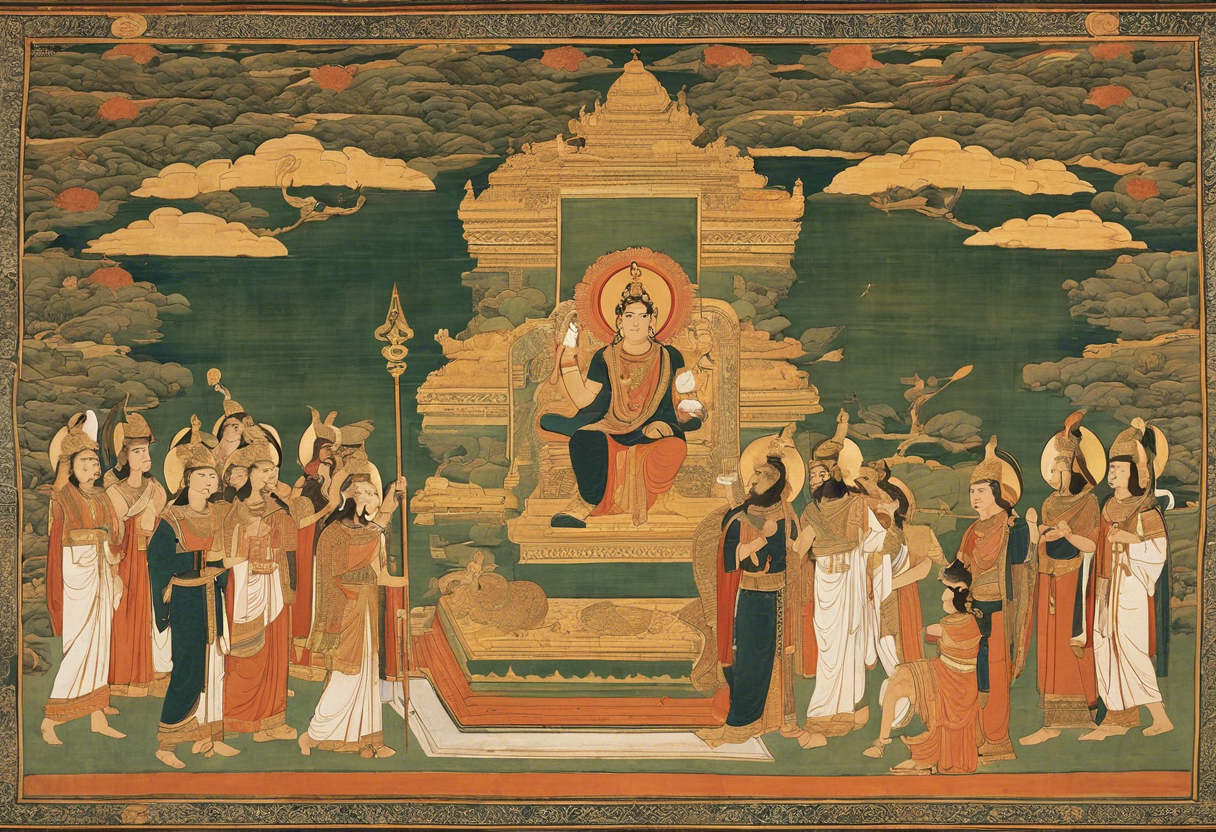
Ancient Egyptian art provides valuable insights into the depictions of gods and their symbolism within the Egyptian pantheon. Through intricate artworks, the gods were visually represented in a variety of forms and styles, each carrying significant meaning and conveying their unique attributes.
Anthropomorphic Representations
The gods in ancient Egyptian art were often depicted in anthropomorphic forms, combining human features with specific animal characteristics. This practice, known as therianthropy, aimed to emphasize the divine qualities and associations of each deity. For example, the falcon-headed Horus symbolized divine kingship and sky symbolism, while the lioness-headed goddess Sekhmet personified power and destruction.
Symbolic Attributes
To distinguish between different deities, ancient Egyptian artists incorporated specific symbols and objects associated with each god into their depictions. These symbols acted as visual identifiers, helping to highlight the god's specific domain or function. For instance, the ibis-headed Thoth was depicted holding a writing palette and pen, symbolizing his role as the god of writing, knowledge, and scribes. Similarly, the crook and flail were often featured in representations of Osiris, signifying his authority over rulership and the afterlife.
Iconographic Imagery
Certain gods in ancient Egyptian art were represented by universally recognized symbols and iconographic imagery. These iconic representations allowed for easy identification and quick visual understanding of the deity in question. An excellent example of this is the sun disk surrounded by a serpent, symbolic of the sun god Ra. This iconic imagery frequently appeared in various contexts, such as mural paintings, relief carvings, and amulets.
Role of Colors
Colors played a vital role in depicting the gods in ancient Egyptian art. Each color had specific symbolism and was carefully chosen to enhance the divine characteristics and associations of a deity. For instance, the color green was frequently used to represent fertility and rejuvenation, often displayed in representations of the god Osiris. Meanwhile, the color blue was associated with the sky and was commonly used to represent gods with celestial attributes, such as Nut, the goddess of the sky.
Regional Variation
It is important to note that the depictions of gods in ancient Egyptian art were not uniform across all regions. Different temples and locations might have distinct artistic styles and iconography specific to their regional worship practices. Consequently, the same deity could have varied representations depending on the geographical location, emphasizing the regional and local beliefs within the overarching Egyptian pantheon.
In conclusion, the depictions of gods in ancient Egyptian art were rich in symbolism and conveyed through various artistic techniques. The combination of anthropomorphic forms, symbolic attributes, iconic imagery, colors, and regional variation allowed for a multifaceted understanding of the gods and their significance within the complex tapestry of ancient Egyptian religious beliefs and practices.
Influence of Egyptian Mythology on Modern Culture

The influence of Egyptian mythology on modern culture is undeniable. Throughout history, Egyptian mythology has captivated the minds of people all over the world and continues to inspire various aspects of contemporary society. From literature and art to film and fashion, the enduring legacy of Egyptian gods and goddesses can be found in numerous aspects of our daily lives.
One of the most apparent influences of Egyptian mythology is in the field of literature. Many authors draw inspiration from ancient Egyptian stories and legends, incorporating elements of their mythology into their own works. For example, the renowned author Rick Riordan incorporates Egyptian deities and mythological figures in his "Kane Chronicles" series, which follows the adventures of modern-day siblings who discover their ties to ancient Egyptian gods. By integrating Egyptian mythology into his novels, Riordan introduces readers to this rich and fascinating ancient culture.
Egyptian mythology also plays a significant role in the world of art. The iconic imagery of Egyptian gods and goddesses, such as Horus, Anubis, and Isis, can be seen in various forms of artistic expression. Artists often draw upon the symbolism and visual representations of these deities to create visually striking and meaningful works of art. This fusion of ancient Egyptian mythology and modern art allows viewers to connect with the spiritual and mystical aspects of Egyptian culture.
Furthermore, the film industry has been greatly influenced by Egyptian mythology. Countless movies have featured Egyptian gods and goddesses as central characters or have drawn inspiration from their stories. The blockbuster film "The Mummy" franchise, for instance, explores the archaeology of ancient Egypt and intertwines it with supernatural elements from the country's mythology. These movies serve as a bridge between ancient Egyptian culture and modern popular culture, promoting interest and curiosity about this mystical civilization.
The influence of Egyptian mythology is not limited to literature and film. It has also permeated into the world of fashion. Egyptian motifs and symbols can be found in clothing designs, jewelry, and accessories. The eye of Horus, an ancient protective symbol, is often incorporated into fashionable accessories, such as bracelets and necklaces. This fusion of ancient Egyptian iconography with contemporary fashion trends not only adds a touch of mystique but also connects individuals to the rich history and culture of ancient Egypt.
In conclusion, the impact of Egyptian mythology on modern culture is undeniable. From literature to art, film to fashion, ancient Egyptian gods and goddesses continue to inspire and captivate the imagination of people across the globe. By preserving and cherishing the mythology of ancient Egypt, we ensure that the powerful stories and symbolism of the gods and goddesses live on, contributing to the richness and diversity of contemporary culture.
Controversies and Misconceptions Surrounding Egyptian Gods
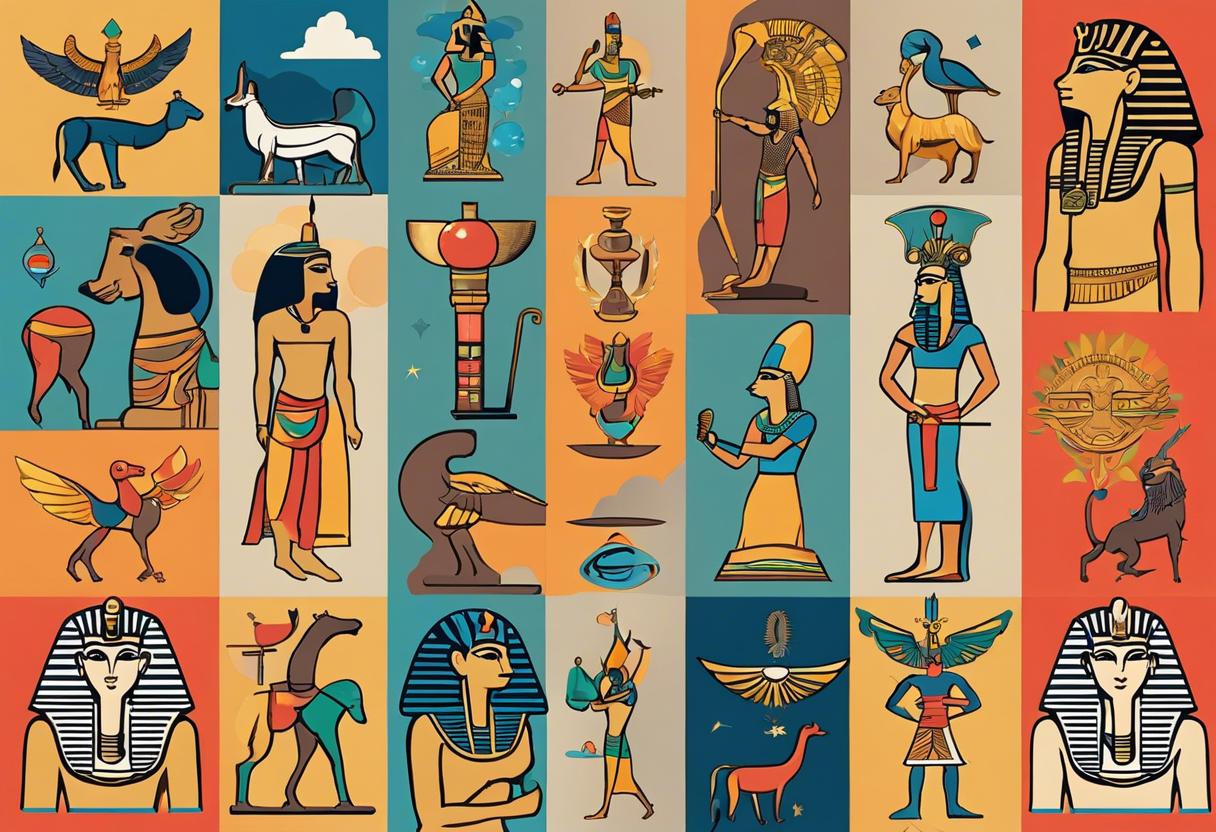
Throughout history, there have been numerous controversies and misconceptions regarding the ancient Egyptian gods. These deities, worshipped by the people of Egypt for thousands of years, have sometimes been misunderstood or misinterpreted by those unfamiliar with the intricacies of Egyptian mythology. In this section, we will explore some of the most common controversies and misconceptions surrounding these gods.
1. Polytheism vs. Monotheism
One of the biggest controversies surrounding the Egyptian pantheon involves the misconception that the ancient Egyptians were solely polytheistic in their religious beliefs. While it is true that the Egyptians worshipped a vast array of gods and goddesses, it is important to note that their religious practices were more nuanced than a simple polytheistic system. The concept of monotheism can be observed in certain periods of Egyptian history, particularly during the reign of Akhenaten, when the pharaoh promoted the worship of a single god, Aten.
2. Animal-headed Gods and Symbolism
Another controversy arises from the depictions of gods as having animal heads, which has led to the misconception that ancient Egyptians worshipped animals. In reality, these animal-headed gods were symbolic representations, embodying certain attributes or characteristics associated with the animal in question. For example, the god Thoth, often depicted with the head of an ibis, was associated with wisdom and writing. These depictions were not meant to be taken literally, but rather symbolize the qualities that the gods possessed.
3. Godly Family Dynamics
The complex familial relationships among the gods have also raised controversy and confusion. Some misconceptions arise from the cross-representation of gods as both siblings and spouses. For instance, the goddess Isis was both the sister and wife of the god Osiris. It is important to understand that these relationships were not seen in the same way as human relationships and were meant to symbolize certain aspects of creation, divine order, and power dynamics within the Egyptian pantheon.
4. Intolerance and Destruction of the Egyptian Gods
During periods of religious and political upheaval, there were instances of intolerance and destruction of the ancient Egyptian gods. The most notable example of this was during the reign of Akhenaten, who attempted to substitute the worship of traditional gods with the sole worship of Aten. Temples and images associated with other gods were defaced or destroyed during this period, leading to the removal of the names and representations of these gods from public consciousness for a time.
5. Cultural Appropriation and Misuse of Symbols
In recent years, controversies regarding cultural appropriation and misuse of ancient Egyptian symbolism have emerged. Many individuals and organizations have used Egyptian iconography for various purposes without understanding the true cultural and religious significance behind these symbols. This can lead to misunderstandings and misrepresentations of the gods and their significance in ancient Egyptian society.
6. Interpretation and Fragmentary Evidence
Lastly, it is important to acknowledge that the interpretation of ancient Egyptian religious beliefs and the gods themselves are based on fragmentary evidence, such as temple inscriptions, papyrus texts, and artwork. The limited amount of surviving evidence can sometimes lead to differing interpretations and further controversies among scholars and historians.
In conclusion, the controversies and misconceptions surrounding the ancient Egyptian gods highlight the need for a deeper understanding of the religious and cultural context in which these deities were worshipped. By examining these controversies, we gain a greater appreciation for the complexities of the Egyptian pantheon and the significance it held in the lives of the ancient Egyptians.
Conclusion: The Timeless Legacy of Egyptian Mythology
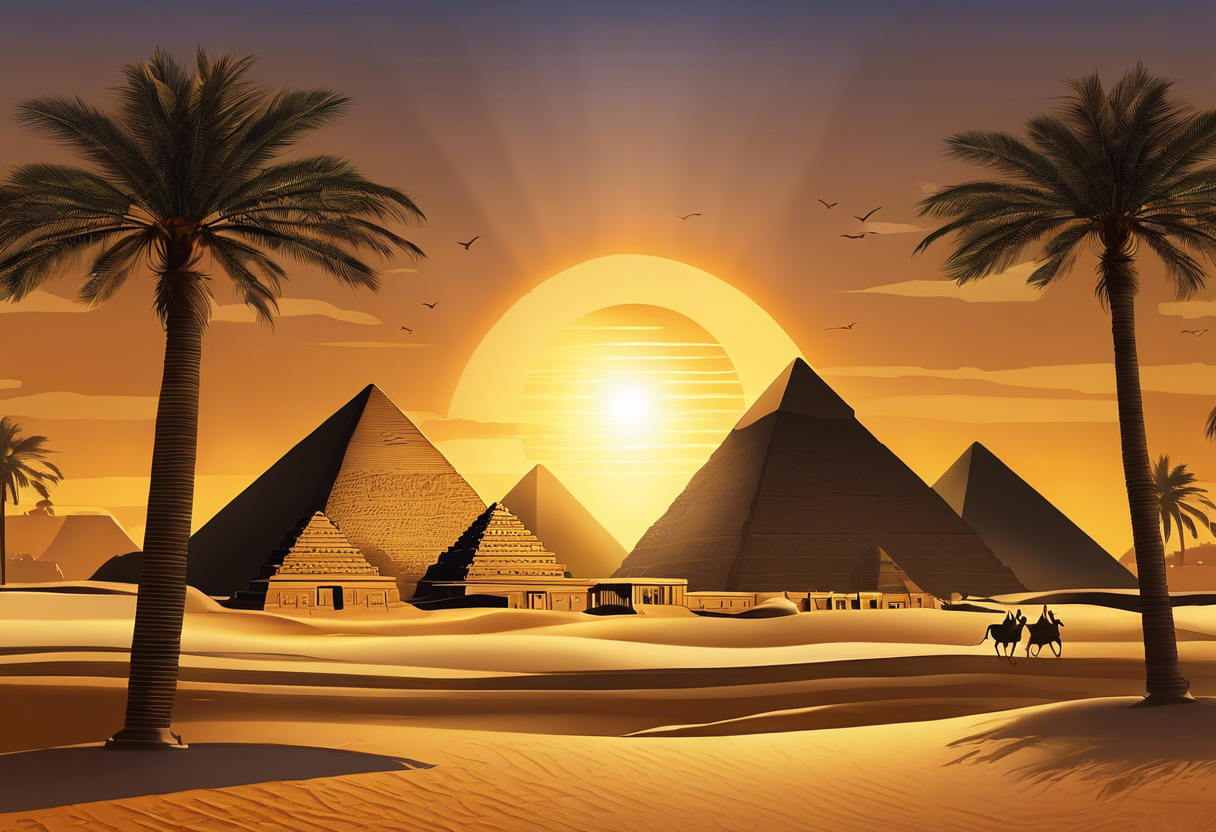
The ancient Egyptian pantheon is a rich and complex system of gods and goddesses that played a central role in the religious beliefs and practices of the ancient Egyptian civilization. Their mythology reflects the profound connection between the Egyptians and their natural environment, as well as the societal values and aspirations of the time.
The gods and goddesses of ancient Egypt represented various aspects of life, nature, and the divine. They were believed to have the power to influence the world and were often depicted as anthropomorphic beings with animal or hybrid features. Each deity had a specific domain and function, and their stories and symbolism were intertwined with the daily lives of the Egyptians.
One of the key characteristics of Egyptian mythology is its enduring legacy. The myths and stories of these gods and goddesses have captivated the imagination of people throughout history and continue to inspire and influence art, literature, and popular culture to this day. From ancient times to the present, the tales of gods like Ra, Isis, Osiris, and Horus have been retold and adapted, making them a timeless part of human heritage.
The symbolism associated with each deity also holds tremendous significance. The gods and goddesses represented not only natural and cosmic forces but also abstract concepts such as wisdom, fertility, justice, and protection. Their images, symbols, and representations were used extensively in religious rituals, temple architecture, and funerary practices, leaving an indelible mark on Egyptian art and culture.
Furthermore, the religious beliefs and rituals associated with the Egyptian pantheon served not only a spiritual purpose but also a social and political one. The pharaoh, as the earthly representative of the gods, used their divine authority to legitimize his rule and maintain order in society. The temples dedicated to the gods served as centers of religious and communal life, bringing people together in shared worship and fostering a sense of collective identity.
In conclusion, Egyptian mythology provides us with a window into the worldview, spirituality, and cultural values of one of the oldest and most influential civilizations in history. The gods and goddesses of the Egyptian pantheon embody the timeless human quest to understand and connect with the supernatural and spiritual realms. Their stories and symbols continue to resonate with us, offering insights into the mysteries of life, death, and the eternal cycle of existence. The legacy of Egyptian mythology endures as a testament to the enduring power of human imagination and the capacity of ancient civilizations to shape our understanding of the world.
